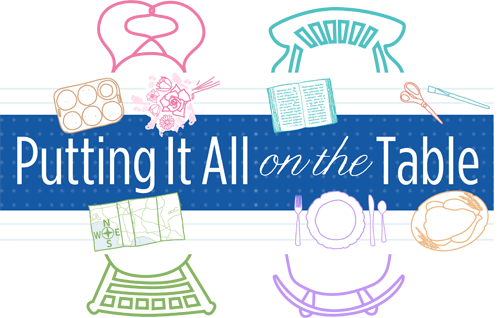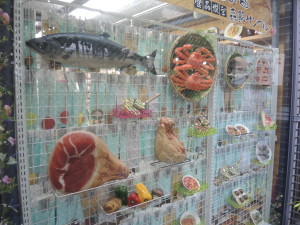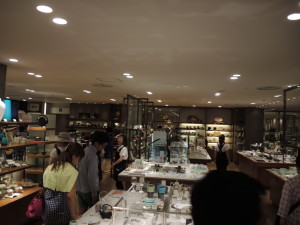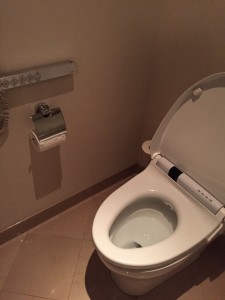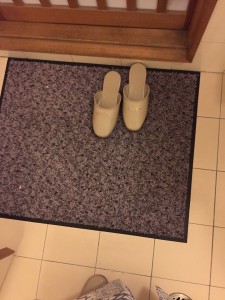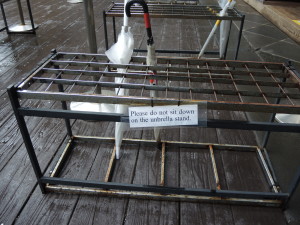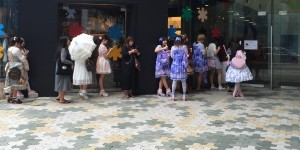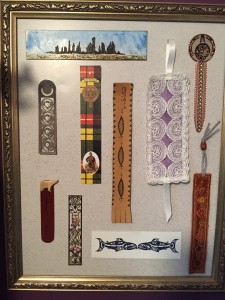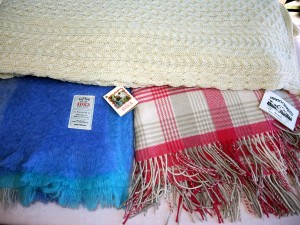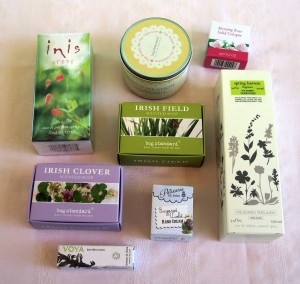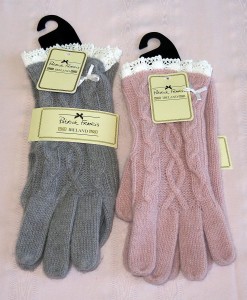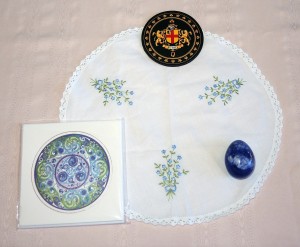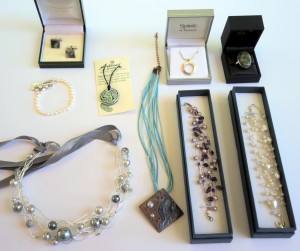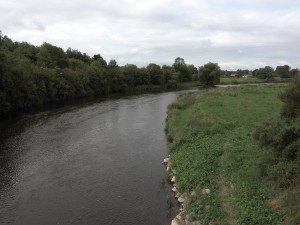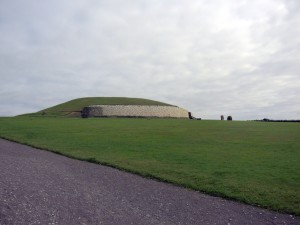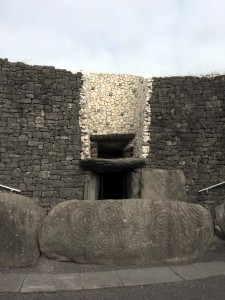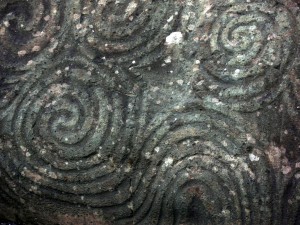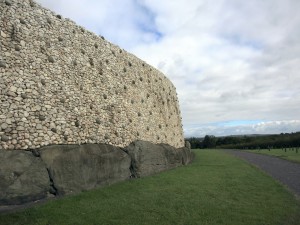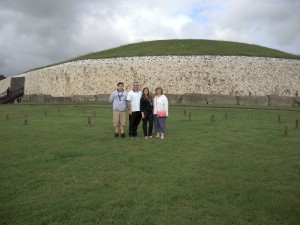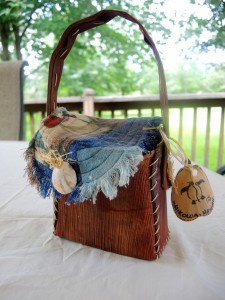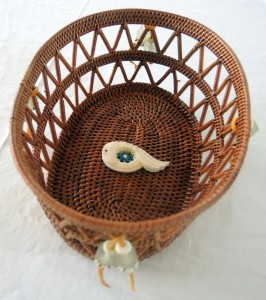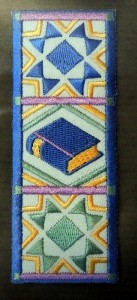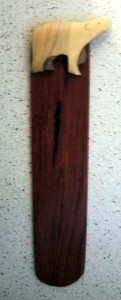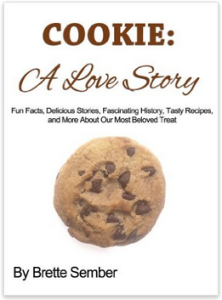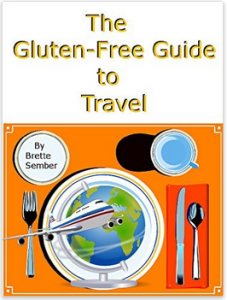I’ve been to six Caribbean islands (not counting the Keys) and St. Lucia is coming in at number two on my best shopping list. There isn’t a lot of shopping on the island, but what there is, is excellent. If you can tear yourself away from the baby soft sand on the beaches, the glorious peaks, and the excellent dining, shopping should be high on your list.
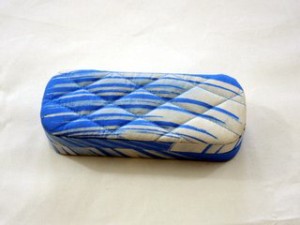
Batik glasses case: Caribelle Batik
Although St. Lucia is not huge (28 miles long, about 238 square miles total), it is time-consuming to get around because
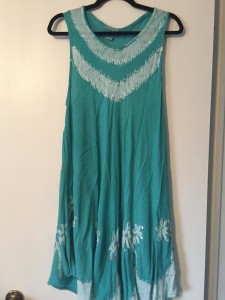
Caribelle Batik dress
the roads are mountainous, narrow, and completely unlabeled. Because of this we concentrated on three shopping areas: Castries, Rodney Bay, and Choiseul. Plan to break this up into at least two days. Choiseul is far south and is a day unto itself. If you are staying in the south, you will want to come north only once since it is a long way.
Castries
Everything you read will tell you to go to the Castries Market. I’m telling you don’t bother. This is just like any other
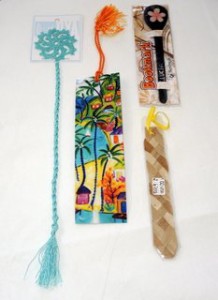
Bookmarks from various shops
Caribbean market. It’s all junk made overseas. If you’re looking for cheap, mass-produced “souvenirs,” make it a stop. I’m not interested in any of that, so we took a peek and then ditched it. The shopping you should be interested in is up in the hills. And it’s really hard to find. Google Maps essentially threw up its hands and said “Good luck!” to us. It did get us close enough to spot a sign for one of the shops we were looking for and once there we were able to get directions to the other places we wanted to find. It was worth a trip for the shopping and also for the amazing view up there.
Caribelle Batik
This was the only store we found on our own and it was worth it. St. Lucia is known for batik and this is the place to go to buy it. You can watch a demonstration, enjoy the view from their terrace,
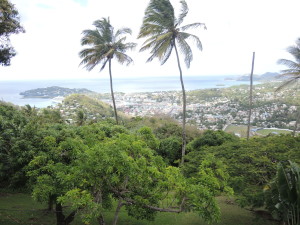
The view from Caribelle Batik
and do a lot of shopping. There’s even a free washroom (hard to find on the island!). If you visit when a tour bus is there, there are also refreshments and music. We were the only shoppers the day we visited. The shop has a large selection of batik clothing for men, women, and children. I’m giving them a special shout out since they carried some plus sizes which are always hard to find in the Caribbean. Batik purses, glasses cases, bags, scarves, wraps, and more are also available. I toyed with buying a large wrap and using it as a tablecloth, but couldn’t find quite the right one. There is a fascinating collection of botanical jewelry made from threads and thin yarn. Very unique. It wasn’t quite right for me, but is worth a look. You’ll find other souvenirs such soaps made on the island, mugs, towels, magnets, flags, bookmarks, bottled sauces, and some art prints. We spent a lot of time browsing and I left with a dress, soap, glasses case, tea towel (which I use as quirky napkins) and bookmarks. Get directions to the other shops listed below while you are here. They are simple to find with directions.
Bagshaws
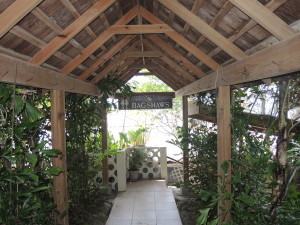
Bagshaws
Bagshaws is another batik house and was not a favorite for me. They seem to be catering to tour buses. They have one large, entire room for demonstrations and not a
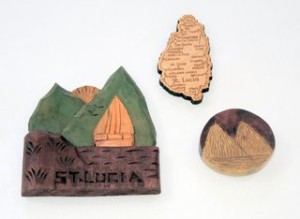
Magnets from various shops
lot to purchase. Most of the purchases don’t even look like batik and are floral prints. I did buy a Bagshaws tea towel at the airport of all places and did not see that particular design at the shop. We visited at the end of the tourist season so they may have more earlier in the year. It is also likely to be livelier if you come when a tour group is there. They also have a lovely view. Another free washroom here as well.
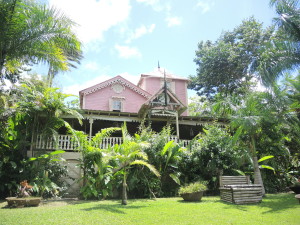
The Pink Plantation House
The Pink Plantation House
I fell in love with the Pink Plantation House which is a stunning old plantation home set on the side of a hill with glorious views. It’s a restaurant with an interior room that sells locally made pottery. I bought only a bookmark here since the pottery ended up not quite being my thing, but it was beautiful and well-made and I highly recommend it. Plan to stop for lunch. The menu looked good and it’s an amazing setting for a relaxed lunch.
Eudovic’s Art Studio
I didn’t make any purchases at this shop either, which contains local, handmade, local wooden masks. They are beautifully done and worth a peek if masks interest you.
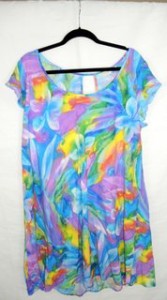
Sea Island Cotton dress
Rodney Bay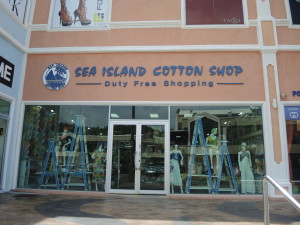
Rodney Bay is the area that was the easiest navigate since everything is on one flat road in a highly trafficked tourist area, right at Reduit
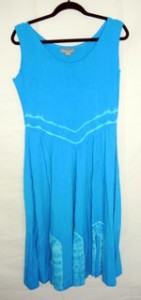
Sea Island Cotton dress
Beach. There is even a parking ramp, which was free when we were visiting. Be sure to check out the beach (you pull in right past the police station and park next to the sand). The beach has a view of Pigeon Island and the bay is filled with sailboats. Chairs can be rented and it’s a great place to spend an afternoon.
Sea Island Cotton
This shop is in the Baywalk Shopping Mall (but has an entrance on the street as well), next to the grocery store (which is of Whole Foods quality, a stark comparison to most stores on the island: they’re catering to the yachts). This shop is either owned by the same people as Caribelle Batik or Caribelle is a big vendor. There is a reasonable selection of Caribelle Batik items in this shop (great if you don’t want to wind up the hill in Castries). They have a large selection of other clothing as well and my daughter and I both bought several beautiful and very unique to the Caribbean pieces here. The likelihood of me being able to wear these tropical sundresses in Buffalo is slim, but I had to own them (I’ll just have to come back to the Caribbean to wear them!). They also carry mugs, toys, frames, magnets, purses, bags,
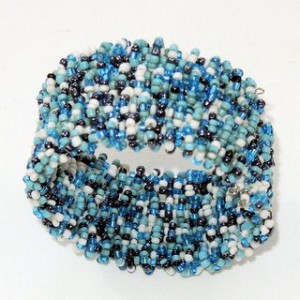
Bracelet from Sea Island Cotton
towels, and jewelry. They have the same botanical jewelry Caribelle Batik carries but also have a selection of mass-produced pieces that are not local. Some of those were unique and I did buy a beaded bracelet cuff. Pop into the grocery store next door (enter through the mall or parking garage) to buy bottled sauces (I brought home banana ketchup and passion fruit sauce), dried sea moss, dried cinnamon in big bunches, or cacoa sticks for making cacao tea.
Island Mix
Walk down to where the road curves to the left for the beach (or drive and park your car along the beach side) to visit the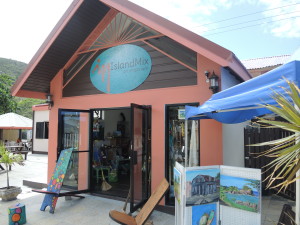
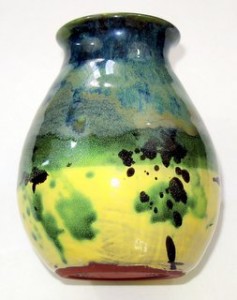
Choiseul craft pottery
tiny artisan shop right near the corner. Everything in the shop was locally made. I bought only a magnet, but eyeballed scarves, jewelry, plates, artwork, ornaments, and more. Everything in this shop is well-made and lovely.
Choiseul
If you are staying in the Sugar Bay area or are driving down to see the volcano, Choiseul is just a bit further south. Google Maps again thumbed its nose at us, but we were able to stumble on the first shop and then get directions to the second. Both are
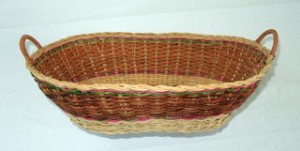
Choiseul craft basket
on the main road in the area, coming south from Sourfriere. This was the best shopping in my opinion.
Choiseul Arts and Crafts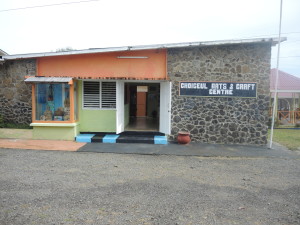
This shop does not look fantastic from the outside, but it really was delightful inside.
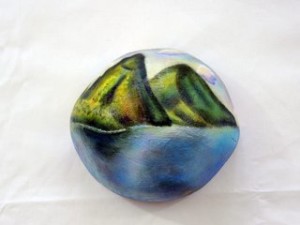
Choiseul craft coconut
Everything is handmade on the island by a variety of artisans. The ladies running the shop had a very heavy accent and were a bit hard to understand, but were helpful. They took only cash (everyone on the island will take US dollars without an
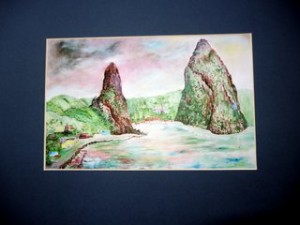
Choiseul gallery print
issue) and had a free washroom (score!). The shop carries a big collection of baskets and of course I had to have one. They also have pottery (I bought a vase), magnets, dolls, animal figurines, cacao
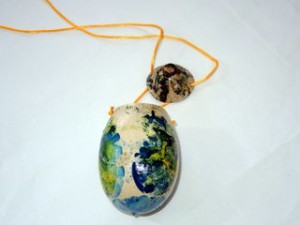
Calabash basket from Choiseul gallery
tea sticks (basically a log of pressed cocoa that you grate over hot water to make a drink), and some artwork. I bought half a coconut painted with the Pitons.
Choiseul Art Gallery
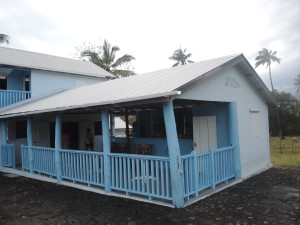
Choiseul Gallery
This was my biggest find of the trip. Harriet and her husband came to St.
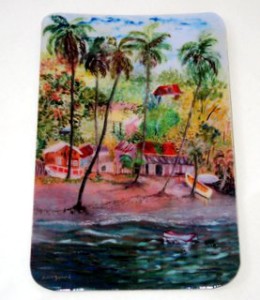
Choiseul gallery tray
Lucia from England. They bought a small farm and opened an art gallery. Their dogs and goats are running around. Harriet is an artist. She makes beautiful paintings. She’s also written a book. Her husband is handy and crafts amazing things out of island fruits, paper, metal, and just about anything he can get his
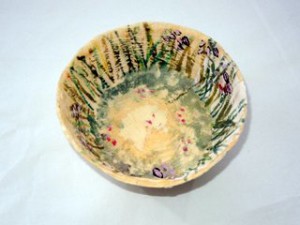
Choiseul gallery paper bowl
hands on. This shop is not to be missed. The only thing that kept me from buying half of it was that their credit card machine was down and we had to pay with the limited cash we had on us. They were lovely people to talk to and I could have bought just about everything they were selling. I came home with a print, a
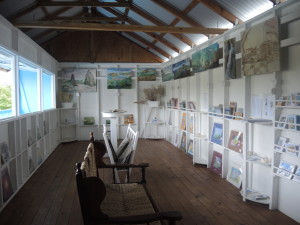
Inside Choiseul gallery
calabash basket, a tray, and a bowl made of paper. This is a not to be missed shop.
I’ve been to six Caribbean islands (not counting the Keys) and St. Lucia is coming in at number two on my best shopping list. There isn’t a lot of shopping on the island, but what there is, is excellent. If you can tear yourself away from the baby soft sand on the beaches, the glorious … Read more →
 Frommers just published a guide to the best duty free shopping at airports. I am not a duty free shopper since I am generally not looking for booze or expensive jewelry or handbags, however, I’ve been known to browse at the airport, duty free or not. And if I have a layover, I will most definitely pop into the shops in my terminal. In general, airport shopping is nothing more than a diversion while you’re waiting to board, but on occasion I’ve stumbled onto some nice finds.
Frommers just published a guide to the best duty free shopping at airports. I am not a duty free shopper since I am generally not looking for booze or expensive jewelry or handbags, however, I’ve been known to browse at the airport, duty free or not. And if I have a layover, I will most definitely pop into the shops in my terminal. In general, airport shopping is nothing more than a diversion while you’re waiting to board, but on occasion I’ve stumbled onto some nice finds.